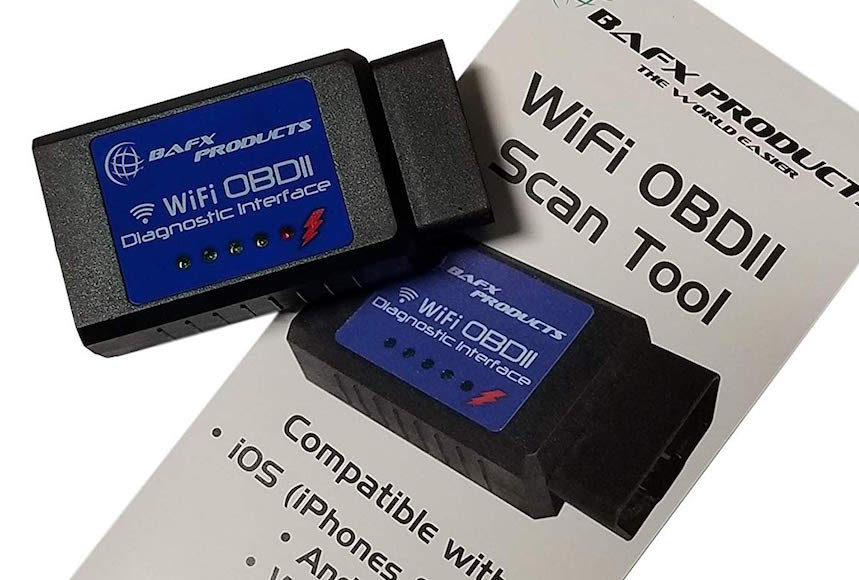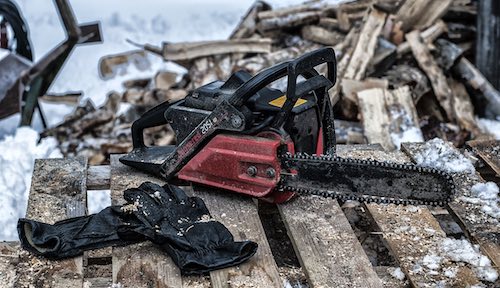
Or maybe you were just planning on riding the dirtbike with the kids. Whatever the case may be, your tool or toy won’t start. And it always seems to happen at the exact wrong time. Well, I am here to help and to helpfully give you the tools and skills you need to quickly know what is wrong with your engine.
It affects 2-strokes and 4-strokes similarly, but the smaller the engine typically the more finicky the engine will be. For example, chainsaws have tiny carburetors and very small passages for fuel to pass through. On the other side of the coin, a lawn mower will have a much larger carburetor. Therefore, a much less likely chance of becoming clogged.
There is one tip or trick that will help you diagnose what is wrong with your engine super quickly, so you don’t waste your time throwing parts at it. I picked this tip up from an old-school small engine mechanic who I would watch while he worked. This was the test he did on all small engines that any customer brought in for any no start condition.
You will need carb cleaner (starter fluid works but I was scolded for using it) and a tool with an engine that isn’t starting. This works on everything from weed whackers/lawnmowers/chainsaws two-stroke or four-stroke. There are some minor difference for every different type of engine, but if you understand these concepts you’ll be %90 of the way to diagnosing your no start.
Table of Contents
The Quickest Small Engine Pro Tip For Diagnosing a No Start:
Find the Carburetor and get access to it. You want to be able to spray directly into the back of the carb. You can also just remove air filter, and put the straw of the carb cleaner pointed towards the carb and spray (more carb cleaner may be needed)
- Spray the carb cleaner for a quick one-second burst directly into the back of the carburetor (you will need to remove air filter first).
- Immediately try to start the engine. There are three potential outcomes. It starts and sputters for a bit then starts running, it runs for a second and dies, or nothing at all happens.
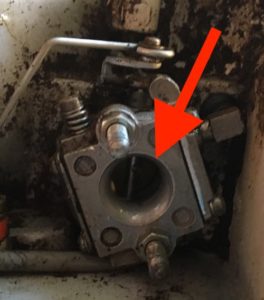
The point of doing this is so you gain information about what is wrong with your engine. Each one of these outcomes gives you a clear path forward for your diagnosis. Maybe it seems like a bad thing that the engine didn’t start, but in reality, it now gives you the correct path forward.
You’ll be on your way to fixing it in no time!
Now just follow the diagnosis tree outlined below based on what happens.

#1: Engine runs for a second but quickly dies/sputters/bogs out:
- You now know you have spark and compression.
- You can rule out a
- Bad spark plug
- Faulty wire
- Or junk coil/CDI/Other ignition parts.
No need to waste money on those parts. The spark was strong enough to ignite the carb cleaner, more than likely it is good enough to light gasoline as well. The engine will run when it has fuel (which instead of gasoline is now the carb cleaner acting as a fuel). Therefore, since you know the engine will run when you’re feeding it fuel you now know the problem lies on the fuel side.
Potential problems on the fuel side could be (Always follow the KISS rule– Keep It Simple Stupid):
- Bad gasoline (Gas goes stale in around one month without fuel stabilizers)
- Lack of gasoline in the tank (I know you’re smart enough to make sure there is enough gas / I sometimes am not though)
- Vapor lock in a small engine (crack the gas filler cap– do you hear a suction sound?) Replace gas cap or clean gas cap vent if this is the case on a small engine. This happens on my Stihl leaf blower for example, I just crack the cap every 10-20 minutes of use/or before I try and first start it.
- Clogged Fuel Filter
- Clogged Carburetor– research cleaning your carburetor and follow the steps online.
- Vacuum leak around the carb allowing more air in and leaning out the mixture.
Quick pro tip for diagnosing fuel issues:
The best advice I can give you is to follow the gas from the start to the end of its journey and make sure you know it is reaching the carburetor unobstructed. Start at the tank and making sure you see gas flowing all the way to the carburetor.
To read more about fuel diagnosis read my post where I go into in-depth detail here.
Question: Does the use starter fluid or carb cleaner to start my engine cause damage?
Answer: Yes, it can. But if used in moderation, it will not. Like everything in moderation, it is totally okay.
However, if you start using a half can of carb cleaner starting your engine every time, then yes you will do damage.
If it just needs a couple short bursts to get over that first cold start in the morning, you will likely not cause any damage.
Question: Why does starter fluid or carb cleaner cause damage if used too much?
Answer: Because carb cleaner is very explosive and extremely flammable.
Your engines valves and piston rings are plenty strong enough to run for a couple seconds on carb cleaner, but if you spray the whole can trying to drive it home, you will surely mess up your engine. With two-stroke engines, the lubrication for the pistons comes from the oil mixed in the gasoline. Carb cleaner, or starting fluid, lacks those lubricating qualities of mixed gasoline.
Using starter fluid or carb cleaner is meant to be a diagnostic tool only!
Sometimes all an engine needs is a little help to get started due to a failing choke, or some other cause that may not be worth it to you to repair. In that case, it is okay to give the engine a little spurt when starting it. If it becomes more than just a little spurt– make sure to actually fix the problem.
#2: The engine won’t fire or pop even with carb cleaner sprayed directly in:
This tells you that even in the presence of a very flammable fuel in the cylinder (starter fluid/carb cleaner) your engine still is producing no explosion in the cylinder. The most likely reason that this is happening, or isn’t happening, is a lack of a spark inside the combustion chamber. You should now focus your efforts on testing whether your ignition side (spark side) is working.
Most common causes of no spark on small engines:
- Bad spark plug (or improperly gapped/the wrong type of plug)
- Loose connections between the spark plug wire and the head of the spark plug (test with Multimeter)
- Faulty CDI, points, magneto, whatever your engine uses to generate the pulse of spark.
Once again do not forget about the KISS mantra when diagnosing engines. KISS stands for keeping it simple, stupid! You will hear me say that all the time, as an encouragement to avoid jumping to conclusions. Start with the simplest answer and work from there.
It is never a bad idea to have a spare spark plug and throw it in to see if it is the problem. This does not count as “throwing parts,” because it is a small engine and spark plugs are cheap.
On a V8 engine then yes this would be considered throwing parts at it.
How To Test Spark On A Small Engine the Easiest Way:
To test whether or not your engine is making spark the easiest/fastest way is to use a cheap inline spark tester (which I personally love using). To see a video of an inline spark tester in action click here to go to youtube.
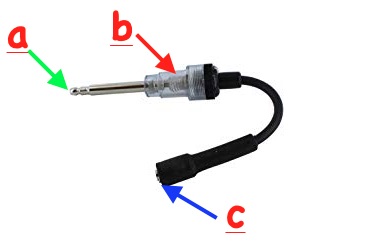
Simply connect it in line with the spark plug wire, and pull or crank the engine over.
Do you see the light flash on the spark tester?
Then the engine is sending voltage to the spark plug, now you should change or check the plug and retry the carb cleaner spray start test.
Question: How do I test whether I have spark without an inline spark tester?
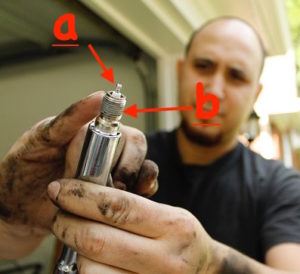
Answer:
- Remove the spark plug from the engine
- Put the spark plug wire back on the tip of the plug like normal except keep the spark plug loose outside the engine.
- Ground the body of the spark plug to the engine block (or wherever you have a good clean ground).
- Pull or crank the engine over while you watch the tip of the spark plug for a spark.
See photo above for further explanation. Or watch this video (click here for Youtube) for an in-depth explanation of how to do this.
Pro Tip: You will need to shade or do this not in direct sunlight– otherwise it will be very hard to see the spark.
#3 Have spark and spark plug is new/gapped and still no running with carb cleaner spray?:
Assuming you did the tests properly, we now need to make sure the actual engine internals are okay. The easiest way to do this for a beginner is to do a compression test. A compression test quite literally measures the amount of compression inside the cylinder of your small engine in PSI (pounds per square inch). A loss of compression can cause a no start condition in an engine that has spark, fuel, and air and still refuses to run.
What low compression feels like and sounds like:
Compression in a small engine can be felt by pulling the starter cord, or on a motorcycle by kicking the kick starter. Both of these actions cause the piston to move inside the cylinder of your engine and compress the air/fuel mixture. If everything is working well, you’ll feel resistance while you pull. It will also sound like the chugging sound you hear on an engine trying to start.
You should feel resistance when you pull the starter cord to start the engine. A good small engine mechanic can usually tell if a small engine has enough compression to start simply by pulling the cord and feeling it.
If it is a scooter or car and has an electric starter, you can also “hear” when a car has no or little compression.
It sounds like an effortless cranking almost. For a video to hear what a car sounds like with no compression click here.
Unless you have worked on a lot of similarly sized engines to what you’re wanting to test the compression on you probably haven’t developed a feel for compression yet. Best do it with the proper tools. Don’t worry compression testers are pretty inexpensive and can be used for years.
- Tools needed to perform a compression test:
- A compression tester kit w/adapters for different spark plug threads.
- This is my favorite compression tester for small engines
on Amazon. You can also use it on your car or truck as well.
- If you just want the cheapest small engine compression tester on Amazon
— this one also works well and will fit most small engines.
- This is my favorite compression tester for small engines
- A compression tester kit w/adapters for different spark plug threads.
How to perform a compression test on a small engine with a compression tester:
- Pull the spark plug out of the head of the engine.
- Find the adapter for your compression tester that threads into the engine block smoothly (do not force it)
- Tighten the adapter in the spark plug hole so the o-ring seats (hand tight is all that is needed!)
- Attach compression tester gauge.
- Hold the throttle fully open on whatever engine you’re testing as you pull the cord or crank it over.
- Keep cranking or pulling until the compression tester will not increase any more.
- If you here any leaking or have no compression showing on the gauge make sure to check all your fittings for leaks.
What causes low compression in a small engine:
There are two types of common small engines, and both are very different. I assume you know the difference, but quite basically two-stroke engines use mixed gas, don’t have valves, and make that loud raspy classic dirtbike noise. For a very in-depth video analysis of both types of engines watch this short YouTube video here.
With a two-stroke engine where there are no valves like a four-stroke engine, low compression is almost always caused by the piston rings failing and not sealing against the cylinder walls. At the same time, the piston rings fail, you will also likely see damage to the side of the cylinder walls.
This is best seen by looking through the spark plug hole with a borescope, or by removing the muffler and looking at the piston/cylinder walls directly.
If your engine is brand new and is already suffering from low compression after only a few hours of uses it is likely caused by one of a couple things. With a two-stroke, the most common cause is running the engine with improperly mixed fuel. On a four-stroke engine, the most common cause of early loss of compression is running the engine without proper cooling or low engine oil.
Two Stroke Compression Loss By Improper Fuel Mixture Leading to Piston/Cylinder Damage:
In a new 2-stroke engine with relatively little use, it is almost always caused by improper fuel mixture by the user.
Many homeowners do not realize how important it is to run properly mixed 2-stroke in their engines. It happens to the best of us, maybe you grabbed the wrong gas can and didn’t use the mixed gas on your 2-stroke engine.
Question: If I run regular gasoline without oil mixed in will it damage my 2-stroke engine?
Answer: Yes! Never run unmixed gasoline in a 2-stroke engine for any period of time. The two-stroke mix oil provides the lubrication, keeps the engine cool, and allows your engine to run without destroying itself. You may or not get lucky and not cause any serious damage if you run your two-stroke with unmixed gasoline.
Except if it is an insane emergency where the only gas you have is 2-stroke, you will do damage to your 2-stroke engine almost immediately.
This is because the oil you mix in to make regular gasoline good for 2-stroke engines provides the lubrication for the piston against the cylinder wall in the engine.
Without it, the engine will overheat, the piston will score the cylinder wall and you will lose compression fast. Always use correctly mixed gasoline usually in a 40 or 50:1 ratio with 2-stroke oil. Check your owners manual.
Having correctly mixed 2-stroke gasoline is the difference between a two-stroke engine that lasts 10 years and one that lasts 10 hours. Make sure you understand how to mix gas and follow the guidelines in your owners manual exactly!
- Pro tip: adding a little extra oil to break in a chainsaw is a great idea! You can always add a touch more oil than the mixture calls for in the owners manual, but never put any less.
The worse that can happen from too much oil is a fouled spark plug, and carbon builds up. With too little mix oil you’ll have cylinder damage and need to rebuild your engine.
Question: What is a low compression number for a chainsaw?
Answer: This depends on the saw but here are some general guidelines I found from my research. Most chainsaws will not run, or run very poorly, below the 100psi compression mark. Anything below 80 psi on the compression gauge, assuming you did the test correctly, will likely cause the no start condition.
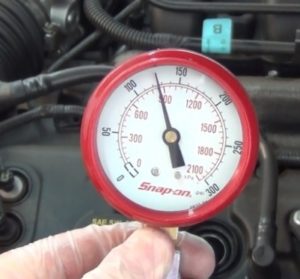
If you’re getting anything below 100 psi compression on your chainsaw it is time to think about rebuilding the engine, or buying a new chainsaw.
You can check what the compression numbers for your chainsaw should be by calling the manufacturer or searching online for your brand, model, and compression numbers.
Many new chainsaws in 2018 will come new off the shelf with compression levels around 120-150 psi. Some modified chainsaws or very large performance chainsaws may have as high as 180+ psi compression levels.
Question: What is low compression for Stihl chainsaws?
Answer: From Stihl directly, any chainsaw below 110 psi is suffering from low compression and could be causing performance issues.
Question: What is low compression for Husqvarna chainsaws?
Answer: Anything below 110psi on any Husqvarna chainsaw will likely cause engine performance issues and further diagnosis should be done.
Pro Tip For Performance Issues on Any Small Engine:
This is a tip from many chainsaw enthusiasts but it applies to all small engines. High compression readings, or within the normal specifications, does not necessarily mean all is well with your engine.
A quick check of the cylinder bore will give you a lot of information combined with the compression reading. To perform a visual check of the cylinder bore while you have the spark plug removed to do a compression test look into the cylinder with a flashlight.
Pull the cord and get a look at the cylinder walls.
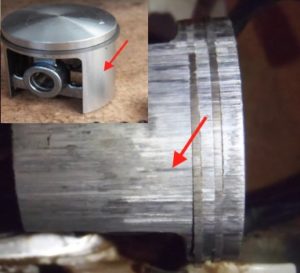
Do they look scored? Rough? Do you see any gouges taken out? Any streaking or blueish colors?
A new piston and cylinder will look like an almost mirrored finish. There will be no gouging in the cylinder wall, and the piston will have a smooth finish.
This tip was taken from my reading on an arborist forum, for a more in-depth discussion read here.
This happens often, and will also cause performance issues in a chainsaw or small engine.
Another way to get an even better look at the health of the cylinder is to pull the muffler off and look through the exhaust port.
Pull the starter cord a bit and get a look at the top of the piston as well. Check the photo to the left to see the difference between a brand new piston, and one from a chainsaw that was completely dead. Why did the piston die? Either it was run with poorly mixed fuel, or it is just due from heavy use. Overtime every piston on every engine will fail, they cannot last forever.
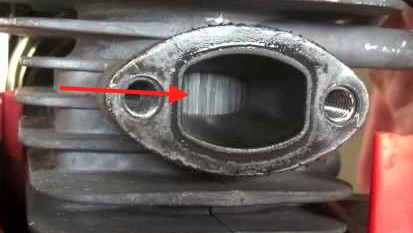
Question: How do I test the compression release fitting on my chainsaw or 2-stroke engine?
Answer: Do not forget, many chainsaws or larger two-stroke engines have compression release tabs to make starting them easier. Some four-strokes also have decompression levers, which operate in exactly the same fashion. This compression release allows you to pull the engine over easier by hand, but if it is faulty it can cause low compression readings. Make sure to check your compression release valve for proper function before freaking out about low compression.
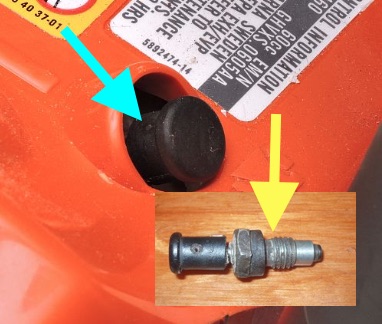
A compression valve quite simply reduces the compression inside the cylinder so that you can more easily pull the starter cord and get it started.
If the valve is faulty it will cause low compression readings due to it being “stuck” open and constantly venting compression. Usually, these won’t cause the compression to drop enough to not start the engine, but may cause other performance issues like poor running, bogging, or low mid rpm power.
They’re relatively simple to check for proper function just follow these steps. The most common way to test if it is bad or not is to remove the compression release valve from the head of the engine, plug it with a matching thread bolt, and re-test compression.
- If no change in the compression is found the compression release is likely functioning well.
- If compression suddenly increases after replacing the compression release valve with a bolt, then you have a malfunctioning compression release valve. Replace it with a known good one, and retest.
- Make sure the bolt you replace the compression release valve is not longer than the compression release fitting threads! Otherwise, you can cause engine damage.
- If you do not want to take anything apart, try mixing dishwashing soap with water to create a bubbly mixture.
- Spray that around the compression check valve, and start the engine like normal.
- Do you notice bubbles around the compression valve while the engine is running and it should be closed?
- If yes, then once again it is bad and replaces the compression valve with a known good one and retest.
Compression levels for other small engines:
Most 4-stroke small engines will require at least 40-psi at a minimum to run at all. They can run at typically much lower compression levels than a 2-stroke chainsaw for example.
However the same logic applies, if you’re getting low compression readings and a no start condition with carb cleaner sprayed directly into the intake, you may have a problem with the piston rings, cylinder, or valves.
Take off the muffler and try to get a look in at the actual cylinder wall/piston.
A borescope also works great for this and allows you to look down the spark plug hole and get an inside view of the cylinder. I personally haven’t sprung to buy one yet, but they allow you to do some pretty cool stuff around the house and on cars. I did some research and you can get a pretty awesome wireless borescope on Amazon here for an amazing price.
It connects your phone through wifi (it puts out its own signal) and you can see a video of what it sees immediately on your screen. It is also like a fifth the price of buying one that has its own screen, so why not just save the money and use your phone!
Make sure to search for your exact engine and the compression readings that it should have when it is new and healthy. Most mechanics agree that around a 20% drop in compression is acceptable over time and the engine should still run. Anything over that will likely cause engine performance issues.
Just like on 2-Stroke engines some 4-stroke lawnmowers/Scooters come with a compression release valve for easier starting. These are typically marketed as “easy-start” engines. Make sure to check those valves first before assuming the engine is toast.
A quick warning about compression tests:
Compression testing is not a tell-all test. Engines, especially small engines, can have a relatively high compression test and still have problems with the piston rings and cylinder bore.
This is because sometimes when cold the piston rings will act ok, but once the chainsaw heats up and the cylinder expands the rings will begin to show how they have failed. A common sign that this is happening is once it is warmed it will stall or die at idle.
The best way to really get an idea of the condition of any two-stroke engine is to pull off the muffler and get a direct look at the piston and cylinder bore. While I won’t go as far as saying that a compression test isn’t a good test, it should only be one part of your no-start diagnosis.
To see a video where the guy goes in-depth about why pulling the muffler is essential when buying a used saw watch here:
One Last Tip For Diagnosing No Starts/Poor Engine Running On Small Engines:
Just like a small engine needs air, spark, fuel, and compression to start an engine also require a clear exhaust escape route. If exhaust cannot leave the cylinder then you will get poor running, no start conditions, and an all-around bogging engine.
This happens all the time on Stihl and Husqvarna 2-stroke engines, other brands have problems as well. Most 2-stroke engines are built with a muffler that includes a spark arrestor, which is basically a screen with lots of little holes in it. The point of a spark arrestor is to keep sparks from the engine shooting out the muffler and causing a fire. Over time this screen becomes clogged as carbon builds up on the little holes and restricts the exhaust to the point it causes engine problems.
This is the cause of probably about %20-30 of poorly running or not starting chainsaws, weed whackers, 2-stroke scooters, or anything with a 2-stroke engine.
Two-strokes are more prone to exhaust clogging due to the nature of a two-stroke engine not burning the fuel as completely as a 4-stroke engine. Two-strokes are dirtier by nature than a four-stroke engine and therefore can easily clog up these spark arrestors in the muffler.
Question: How do I clean a clogged exhaust or spark arrestor on my 2-stroke engine?
Answer: Take off the muffler and if you can split it open to reveal the inside guts of the muffler. You should find a screen looking mesh thing. If you can see through it easier and air can pass through it then it is not the issue. If it is covered in black ash clogging the holes– you need to clean it.
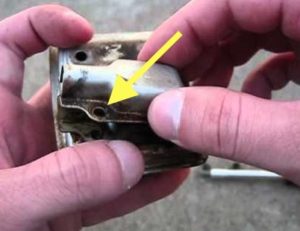
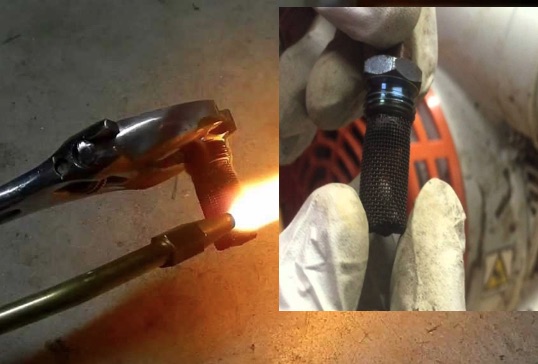
Two quick methods to clean your spark arrestor/clogged exhaust screen:
- Use a torch to heat the spark arrestor red hot
- Yes, you read that right.
- Grab your torch, and heat it up till all the carbon burns off.
- Reinstall it and check to see if that fixes your problem.
- Remove the screen entirely
- I cannot recommend you do this, because it increases the chance that a spark can fly out of your exhaust and start a forest fire.
- However, many arborists and tree workers do this on all their new saws.
- I recommend just cleaning your spark arrester.
- It takes only 5 minutes and could keep you from accidentally starting a forest fire.
The Verdict:
This post was supposed to just be a short little quick tip. I didn’t mean for it to turn into a whole discussion of all the reasons you can have a no start on your small engine. However, having spent hundreds of hours myself working on small engines trying to chase down why they aren’t starting, these are the tips that have stood out to me.
I wanted you to not fall victim to some of the common issues that many people overlook.
Part stores love anyone that doesn’t do any diagnosis and just starts throwing parts at their engine. I have been that person before, and I hope my failures can help you avoid wasting money too.
Follow these tips and tricks and at least you will be well on your way to making an accurate diagnosis before changing any parts.
Final Tip: Avoid Stale Ethanol Gas By Using A Fuel Stabilizer:
One more big clue if you’re trying to figure out why your chainsaw/mower/weed whacker won’t start. Has it been sitting for a while, by a while I mean more than a month without being used?
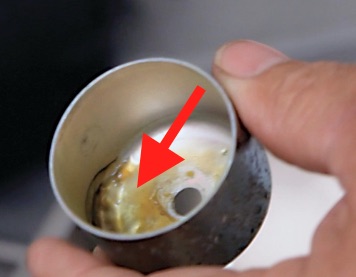
More than likely you are dealing with stale fuel, and you will either need to just flush out the bad gas and put in fresh gas. Or you will have to take apart the carburetor and clean all the gummed up old fuel out. The best way to prevent this is by adding a fuel stabilizer to all your gas, and to make sure to run the engine completely out of fuel before storing it.
I asked my small engine mechanic friend for his favorite fuel stabilizer and he recommended this Marine Grade Fuel Stabilizer on Amazon. Trust me it is worth the little bit of extra money, and it will save you money in the long run.
I wrote another article where I outlined my entire steps for diagnosing a no start which includes even more tips and tricks here.
The main tools that make life easier if diagnosing a no start condition on any small engine:
- Inline Spark Tester
— makes diagnosing whether you have a spark a breeze. It lights up bright enough to see it even in direct sunlight, no more grounding out spark plugs and zapping yourself.
- B-12 Chem
— Literally, that professional small engine grumpy guy I told you about earlier. He scorned me for using starter fluid on my small engines to perform these tests. He swore by this brand of carb cleaner and told me to never use starter fluid. I do not know the science behind it, but I took it to heart and only use this type of carb cleaner.
- Compression Tester W/Adapters
— you can use this on a car, your lawnmower, or your neighbor’s chainsaw. A compression test tells you quickly if something is really wrong, and can speed up your diagnosis fast.
Don’t forget to read my article on the “FastC” method of diagnosing no starts here.
I spent another 10 hours writing that, and I think it will really help you understand what an engine needs to start and run properly if you still feel confused.
If you’re working on cars and you turn the key and nothing happens, that is a totally different animal. I wrote an article about no starts on cars here.









